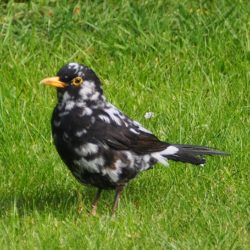Agent
Plumage pigment abnormalities in wild birds are changes in feather colour that can result from a variety of causes. These include inherited genetic conditions, such as leucism and albinism, but also non-heritable conditions such as dietary imbalance (see ‘Signs of disease’ below).
Species affected
Many wild bird species can be affected by plumage pigment abnormalities. However, in GB they are most frequently reported in the blackbird (Turdus merula), house sparrow (Passer domesticus), jackdaw (Corvus monedula), and carrion crow (Corvus corone).
In many species, blackbirds in particular, progressive greying is the most common type of plumage pigment abnormality observed. Conversely, in carrion crows, particularly juvenile birds, dietary imbalance is considered to be the most likely cause of white feathering: whilst the mechanism for this is not fully understood, it may result from a shortage of dietary protein.
Signs of condition
There are multiple inherited genetic conditions that can lead to plumage pigment abnormalities, for example:
• Leucism: usually causes bilaterally symmetrical white patches (partial leucism), or overall white plumage (complete leucism), due to the lack of melanin pigments in the feathers and/or skin.
• Albinism: rare in wild birds, albinism is caused by the absence of an enzyme involved in the production of melanin. Albino birds are totally white, unless carotenoid pigments that produce plumage of different colours are also present; for example, an albino adult goldfinch with carotenoid pigments would appear white except for its red face and gold wing bars. A useful feature to distinguish between leucistic and albino birds is the eye colour; albinos have red-pink eyes (due to blood being visible through the colourless tissue), whereas the eye pigmentation appears ‘normal’ in leucistic birds.
• Dilution: the plumage colour appears diluted, or ‘washed out’, due to reduced melanin production.
• Melanism: the plumage appears dark brown or black due to an excessive production of melanin. Similar abnormalities can also be caused by dietary imbalances, which are difficult to distinguish from true melanism.
Non-heritable causes for plumage pigment abnormalities are:
• Progressive greying: white patches are distributed randomly over the body due to the loss of melanin pigment over time. More white feathers are typically seen with each progressive feather moult, but the feather structure remains unaffected.
• Dietary imbalance: wide white bars extending along the width of the flight feathers are caused by dietary deficiencies affecting melanin production. This condition is common in carrion crows and the wing-coverts and tail feathers can also be affected in advanced cases. In juvenile birds, fault-bars or ‘stress marks’ can occur in the flight and tail feathers when a temporary lack of nutrients interrupts the feathers’ normal growth. As a result, feathers with fault-bars display poor structure in the corresponding area, often in combination with a lack of pigment; they can be weak at this point and more likely to break. In addition to plumage pigment abnormalities, a dietary imbalance over an extended period can also impair the bird’s growth and impact its overall health, resulting in poor body condition and a predisposition to concurrent disease, for example with parasitic infestations.
Most birds with plumage pigment abnormalities do not show altered behaviour, or signs of ill health. However, research suggests that abnormal plumage can increase the risk of predation (as a result of reduced camouflage) and affect the bird’s ability to find a mate (as a result of having a different plumage compared to other individuals of the same species). Furthermore, the reduction in plumage pigment in birds affected by leucism, dilution, or albinism, may weaken their feathers, negatively impacting insulation and flight efficiency.
Figure 1. Blackbird (Turdus merula) affected by progressive greying (photo credit Ian York).
Figure 2. Jackdaw (Corvus monedula) affected by progressive greying (photo credit Richard Winston).
Figure 3. Carrion crow (Corvus corone) with signs of dietary imbalance (photo credit Austin Brady).
Transmission
Genetic conditions leading to plumage pigment abnormalities are congenital (present from birth) and heritable, therefore can be passed from adult to offspring. Non-heritable causes of plumage pigment abnormalities, such as dietary imbalance and progressive greying, are non-transmissible.
Distribution and origin
Sightings of multiple species of wild bird with plumage pigment abnormalities have been reported from across GB.
Risk to human health
No known risk to human health.
Risk to domestic animal health
No known risks to domestic animal health.
Diagnosis
In the majority of cases, plumage pigment abnormalities can be categorised through observation.
If you wish to report finding a dead bird with a plumage abnormality, or signs of other disease in birds, please visit www.gardenwildlifehealth.org. Alternatively, if you have further queries or have no internet access, please call the Garden Wildlife Health vets on 0207 449 6685.
If you wish to report observations of live birds with plumage abnormalities, the British Trust for Ornithology runs a dedicated scheme called ‘Abnormal Plumage Survey’ to gather information on the occurrence of plumage pigment abnormalities in wild birds. Please help by reporting sightings of live birds with plumage pigment abnormalities to this survey, attaching digital images when available (https://www.bto.org/volunteer-surveys/gbw/about/background/projects/plumage).
Prevention and control
In the case of plumage pigment abnormalities caused by dietary imbalance, the condition may resolve once the diet is corrected (for example, if a higher protein food source is obtained) and normal feathers should be produced on the next moult. However, there is no treatment available for plumage pigment abnormalities caused by genetic conditions.
Scientific publications
British Trust for Ornithology ‘Abnormal Plumage Survey’:
https://www.bto.org/volunteer-surveys/gbw/about/background/projects/plumage
van Grouw, H., 2018. White feathers in black birds. British Birds 111: 250-263. https://britishbirds.co.uk/article/white-feathers-in-black-birds/
Royal Society for the Protection of Birds:
https://www.rspb.org.uk/birds-and-wildlife/wildlife-guides/birdwatching/how-to-identify-birds/abnormal-colouration-of-birds/
Acknowledgements
Current funding for the GWH comes in part from Defra, the Welsh Government and the Animal and Plant Agency (APHA) Diseases of Wildlife Scheme (DoWS) https://ahvla.defra.gov.uk/vet-gateway/surveillance/seg/wildlife.htm; and from the Esmée Fairbairn Foundation and the Universities Federation for Animal Welfare.
Disclaimer
This fact sheet was produced by Garden Wildlife Health (GWH) for information purposes only. The GWH will not be liable for any loss, damage, cost or expense incurred in or arising by reason of any person relying on information in this fact sheet.
Date of last update
January 2019



